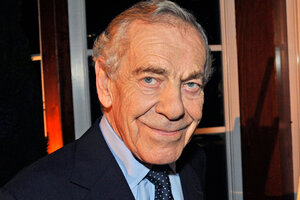Remembering Morley Safer, journalism's Renaissance man
Morley Safer was widely regarded as the best journalist of the Vietnam War era. His reports from the field of war dramatically changed American perceptions of the US role in Vietnam.

'60 Minutes' correspondent Morley Safer smiles during the program's 40th anniversary celebration in New York in 2008. The venerated journalist died Thursday at his home in Manhattan.
John Paul Filo/CBS/AP/File
Compared to the partisan, vertical news of today, Morley Safer, who died at his home in Manhattan on Thursday, represented a different kind of journalism that transcended genre and bias.
Born in Toronto in 1931, Mr. Safer worked in London for Reuters and then the Canadian Broadcasting Company before opening CBS's Saigon bureau in 1965. And it is through his coverage of the Vietnam War that Safer made a name for both himself and the network.
Regarded as the best television journalist of the Vietnam War era, Safer's reporting on the war effort rocked the perceptions of Americans at home. Contrary to the government's message of a peaceful relationship between American soldiers and the Vietnamese public, Safer captured video footage of soldiers burning a hut village to the ground unprovoked and unnecessarily.
"Suave, casual, impeccably tailored, with a long, craggy face, receding gray hair and a wide, easy smile, Mr. Safer was something of a Renaissance man," The New York Times wrote Thursday. "He baked pies and cakes (but swore he did not eat them), played pétanque (a French version of bocce), pounded out scripts on a manual typewriter long after computer became ubiquitous, and painted watercolors of the interiors of countless hotel and motel rooms he had occupied."
And he did not fade into the background as he aged, but rather continued to ask hard questions as a journalist. In fact, Safer only officially retired from 60 Minutes last week. CBS news aired a 60 Minutes special Sunday night, called "Morley Safer: A Reporter's Life," honoring Safer's 46 years with the program.
"It's the range, I think, that is most impressive about Morley," said Jeff Fager, executive producer of 60 Minutes, said in the honorary special Sunday. "I mean, I don't think anybody in the history of broadcast journalism has a body of work as significant, as varied, as large and as impressive as Morley Safer."
Simply listing Safer's most popular coverage proves this variety.
In 1983, Safer did an investigative report on Texas prisoner Lenell Geter, who was serving a life sentence for armed robbery. During his reporting, Safter found new evidence in Mr. Geter's case that proved the prisoner's wrongful conviction and soon led to his release. And as recently as 2011 he drew 18.5 million viewers for his interview with Ruth Madoff, wife of convicted fraudster Bernard Madoff.
Not only could Safer cover war and criminal justice, but he is also famous for stories in the world of art and culture.
In 1993, Safer drew controversy for his segment "Yes, But Is It Art?," which asked contemporary artists to explain why everyday items like urinals were considered high-priced art. And the fashion world was buzzing when he profiled the notoriously reserved Vogue editor Anna Wintour in 2009.
"Morley Safer helped create the CBS News we know today," network president David Rhodes told the Associated Press. "No correspondent had more extraordinary range, from war reporting to coverage of every aspect of modern culture."
During his career Safer won three George Foster Peabody awards, 12 Emmys, two George Polk Memorial Awards, and the Robert F. Kennedy Journalism Award.
This report contains material from the Associated Press.

